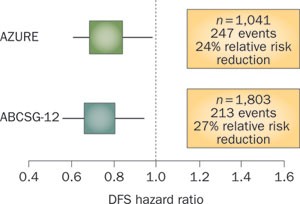Play all audios:
The AZURE trial data add to the uncertainty of whether adjuvant bisphophonates are a valuable addition to the armamentarium in the treatment of early stage breast cancer. Although the
overall trial results were negative, a prespecified subgroup analysis demonstrated a 25% reduction in the risk of relapse and death in postmenopausal patients. Access through your
institution Buy or subscribe This is a preview of subscription content, access via your institution ACCESS OPTIONS Access through your institution Subscribe to this journal Receive 12 print
issues and online access $209.00 per year only $17.42 per issue Learn more Buy this article * Purchase on SpringerLink * Instant access to full article PDF Buy now Prices may be subject to
local taxes which are calculated during checkout ADDITIONAL ACCESS OPTIONS: * Log in * Learn about institutional subscriptions * Read our FAQs * Contact customer support REFERENCES *
Coleman, R. E. _ et al_. Breast cancer adjuvant therapy with zoledronic acid. _N. Engl. J. Med._ 365, 1396–1405 (2011). Article CAS PubMed Google Scholar * Gnant, M. _ et al_. Endocrine
therapy plus zoledronic acid in premenopausal breast cancer. _N. Engl. J. Med._ 360, 679–691 (2009). Article CAS PubMed Google Scholar * Gnant, M. _ et al_. Overall survival with
adjuvant zoledronic acid in premenopausal breast cancer patients with complete endocrine blockade—long-term results from ABCSG-12 [abstract]. _J. Clin. Oncol._ 29 (Suppl.), a520 (2011).
Article Google Scholar * Paget, S. The distribution of secondary growths in cancer of the breast. _Lancet_ 133, 571–573 (1889). Article Google Scholar * Gnant, M. & Clézardin, P.
Direct and indirect anticancer activity of bisphosphonates: A brief review of published literature. _Cancer Treat. Rev._ http://dx.doi.org/10.1016/j.ctrv.2011.09.003. * Eidtmann, H. _ et
al_. Efficacy of zoledronic acid in postmenopausal women with early breast cancer receiving adjuvant letrozole: 36-month results of the ZO-FAST study. _Ann. Oncol._ 21, 2188–2194 (2010).
Article CAS PubMed Google Scholar * Coleman, R. E. _ et al_. The effects of adding zoledronic acid to neoadjuvant chemotherapy on tumour response: exploratory evidence for direct
anti-tumour activity in breast cancer. _Br. J. Cancer_ 102, 1099–1105 (2010). Article CAS PubMed PubMed Central Google Scholar * Aft, R. _ et al_. Effect of zoledronic acid on
disseminated tumour cells in women with locally advanced breast cancer: an open label, randomised, phase 2 trial. _Lancet Oncol._ 11, 421–428 (2010). Article CAS PubMed PubMed Central
Google Scholar * Chlebowski, R. T. & Col, N. Bisphosphonates and breast cancer prevention. _Anticancer Agents Med. Chem._ http://dx.doi.org/BSP/ACAMC/E-Pub/00051. * Gallo, M., De Luca,
A., Lamura, L. & Normanno, N. Zoledronic acid blocks the interaction between mesenchymal stem cells and breast cancer cells: implications for adjuvant therapy of breast cancer. _Ann.
Oncol._ http://dx.doi.org/10.1093/annonc/mdr159. Download references AUTHOR INFORMATION AUTHORS AND AFFILIATIONS * Department of Surgery and Comprehensive Cancer Center, Medical University
of Vienna, Währinger Gürtel 18–20, Vienna, A-1090, Austria Michael Gnant Authors * Michael Gnant View author publications You can also search for this author inPubMed Google Scholar ETHICS
DECLARATIONS COMPETING INTERESTS M. Gnant has received research support from and has served as a consultant for AstraZeneca, Novartis, and Pfizer, and has received lecture fees and honoraria
for participation on advisory boards from Amgen, AstraZeneca, Novartis, Pfizer, Roche, Sanofi-Aventis and Schering. RIGHTS AND PERMISSIONS Reprints and permissions ABOUT THIS ARTICLE CITE
THIS ARTICLE Gnant, M. Adjuvant bisphosphonates—an option with low estrogen?. _Nat Rev Clin Oncol_ 8, 698–699 (2011). https://doi.org/10.1038/nrclinonc.2011.170 Download citation *
Published: 08 November 2011 * Issue Date: December 2011 * DOI: https://doi.org/10.1038/nrclinonc.2011.170 SHARE THIS ARTICLE Anyone you share the following link with will be able to read
this content: Get shareable link Sorry, a shareable link is not currently available for this article. Copy to clipboard Provided by the Springer Nature SharedIt content-sharing initiative

